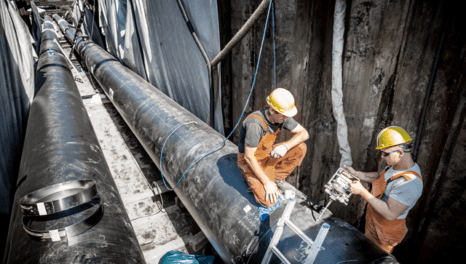The energy revolution
The government recently announced an investment of over £100 million in a new programme called 'Prospering from the Energy Revolution' as part of its Industrial Strategy Challenge Fund, delivered by UK Research & Innovation. This first article from Innovate UK aims to give an insight into this major new programme, with the intention to revisit progress over the coming months and years.
16th July 2018 by Networks

The energy revolution is a commonly used phrase, but it is not often explained well. A revolution usually means the turning upside-down of the normal order of things, and there are good reasons to think we are at the beginnings of a revolution in the energy world. Firstly, there are new demands on our energy systems: decarbonised, affordable energy services; electrification of mobility and heat, flexibility, resilience and last but not least, delivering what consumers want. Secondly, the rate of change of potential technical solutions is rapid, increasing and unpredictable. No-one was able to predict the rapid cost reductions in solar, wind storage and electric vehicles over recent years, but other solutions such as fuel cells, micro CHP and digital platforms enabling peer-to-peer trading or intelligent automation of users’ energy footprint are not far behind in nearing commerciality. This approaching subsidy-free world is a tipping point that can drive uptake of much more distributed systems. In this rapidly changing landscape, there is a clear opportunity to use these new system demands to catalyse intelligent integration of a highly distributed infrastructure, delivering a swathe of societal benefits as a result. These dynamics underpin the energy revolution; it is underway and it is critical that the UK uses it to its benefit.
While the UK has key strengths in complex system integration, ‘smart’ systems solutions, pockets of very interesting technologies, and world-class academia, energy revolution benefits are unlikely to be realised without some help. Putting together an intelligent, highly-distributed system which integrates new technologies and operates within a complex and regulated market is very difficult to do. Significant private investment is needed but the uncertainties of acting within a fast-changing situation are high for companies who are perhaps only operating in one small part of the system. Consumer confidence in new approaches is not easy to judge when the only thing discussed in the public debate is cost. To overcome these barriers, there is a key role for public investment to help bring together complex stakeholder groups who can work together and stimulate proof of new approaches that raise investor confidence.
Unlocking investment is critical to developing a sustainable landscape where replicable and scalable approaches are rolled out across the country and beyond. Investors need to understand the business models that will ensure liquidity and create profitable return rates from projects. While the technology mix is important in fulfilling that business model, it is not the defining factor in a programme that aims to integrate multiple component parts; it is the services that are supplied, the revenue these generate, the capital required, and the contractual relationships involved. That is where the Industrial Strategy Challenge Fund, and specifically the £100m Prospering from the Energy Revolution challenge come in.
Whereas most innovation funding seeks to develop technology and then launch it to market, the Energy Revolution challenge aims to start with business models that can deliver the right outcomes. These determine what services are required and in turn what technical system and components are demanded. This business model-led approach will aim to develop investable propositions while providing consumers with what they actually want, rather than what a particular technology may be able to provide.
Creating prosperous communities across the UK is one of the five foundations of the Government’s modern Industrial Strategy, and ‘place’ can play a role in delivering positive outcomes from the energy revolution. Novel energy approaches based around local areas can make good use of local convening and planning powers in local authorities and enterprise partnerships. They can also help to drive local benefits such as high-value jobs associated with installation and maintenance of more distributed systems (jobs akin to the plumbing and heating industry); lower costs for consumers to help alleviate fuel poverty; increased local disposable income; improved energy efficiency, helping achieve local authority ambitions; and reduced air pollution.
This part of the Industrial Strategy Challenge Fund therefore aims to deliver some key objectives:
- Prove investable, scalable local business models that;
- Use intelligent, integrated approaches to deliver cleaner, cheaper energy services
- Help develop more prosperous and resilient communities
- Benefit the national energy system as a whole.
- Unlock a ten-fold increase in future investment in local integrated energy systems versus business as usual in the 2020s.
- Create real world proving grounds to accelerate new products and services to full commercialisation
- Build UK leadership in integrated energy provision.
These ambitious objectives will be delivered over the coming four years via a series of large scale demonstrators alongside development of future designs for local energy approaches. Between them these will prove the most ground-breaking of today’s local energy plans at scale in the real world and develop the next generation of detailed designs that form a pipeline of investable projects for the 2020s. Gaps in underpinning technologies will be targeted in an innovation accelerator programme. A research consortium will be funded to pull together knowledge from across the academic landscape. And lastly the Energy Systems Catapult will deliver a programme integration service which will provide capability into projects and perhaps most importantly ensure insight from the programme on different types of energy model.
At UK Research and Innovation, we are excited about this ambitious programme, but we cannot deliver it on our own. Its success will depend on the engagement of key stakeholders across the sector and beyond as we seek to accelerate our understanding of the energy revolution. That’s where the industry come in.
Comments
Login on register to comment
Related content

Heat
Electric storage heating – a Cinderella solution
Why has electric storage heating been overlooked as we seek to tackle decarbonising domestic heat?

Heat
Prospects bright for landmark East London Heat Network
New Vattenfall-Cory partnership marks step towards record-breaking heat network capable of serving over 10,000 homes

Heat
New construction director at Switch2 Energy
Appointee brings experience from Vattenfall and Eon
Related supplier content

Power
Load patterns and lockdown: how Covid-19 is impacting electricity networks
Insights into dynamics on the low voltage network as the outbreak unfolds

Downloads
Protect electrical equipment from insulation failure
Insulation faults are a major cause leading to the eventual failure of electrical equipment. Partial discharge (PD) is a very reliable indicator of developing insulation faults. Regular PD testing allows users to detect and analyze PD activity

Heat
How E.ON. is helping the City of London become a zero emissions city
Discover Citigen. Deep in the heart of our bustling capital